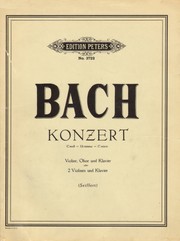
Konzert C moll
By Johann Sebastian Bach
Subjects:
Description: Nach Wilhelm Rusts Beispiel herrschte in den Fachkreisen bisher die Meinung, daß die Urform des Bachschen Konzerts für zwei Klaviere in C moll (Gesamtausgabe Bd. 212 No. 1) ein Konzert für zwei Violinen in D moll gewesen sein müsse. So umgeformt von Max Scheider ist denn auch das Stück jüngst auf dem Leipziger Bachfest 1920 aufgeführt worden. Gleichwohl ist damit die Entscheidung in dieser Frage noch nicht gefallen. Angesichts dieser Sachlage erscheint uns auch die Frage der Tonalität in einem anderen Lichte. Mit der Umformung des Klavierkonzerts zum Violindoppelkonzert hätte die Transposition von C moll nach D moll erfolgen müssen; Bachs Beispiel zwang dazu. Der Hinzutritt der Oboe macht jedoch die Transposition entbehrlich; die Tonart C moll ist für sie gerade bequem traktabel. Noch ain andrer Grund spricht mit. Als Konzert für zwei Violinen in D moll wäre das Stück (abgesehen von der melodischen Führung beider Instrumente) ein Zwilling des bekannten D moll-Konzertes (Gesamtausgabe Bd. 211 S. 41) geworden. Das wäre ganz gegen Bachs Schaffensweise in der Zeit, als er solche Kammermusik schrieb; er bevorzugte vielmehr immer wieder neue Problemstellung. Als Konzert für Violine und Oboe in C moll gewinnt das Stück seine volle Selbständigkeit. Dieser Urform des Konzerts zu ihrem Rechte zu verhelfen, war der Hauptzweck der vorliegenden Ausgabe. Nur an zwei Stellen des ersten Satzes, (Seite 3 und Seite 7) mußte dabei in Rücksicht auf den Umfang der Oboe die Oberstimme des zweiten Klavieres in der Oktavlage geändert werden. Die Umschrift der Oboe in eine zweite Violinstimme wird nach dem oben Gesagten nicht mißverstanden werden; sie will lediglich den Bedürfnissen der Hausmusik entgegenkommen, wo nicht allemal eine Oboe zur Hand ist. - Max Seiffert, inside front cover. With the Concerto in C Minor for Oboe and Violin we have a work for which no original source exists. However, knowing that Bach wrote such a piece, and with a later concerto for two harpsichords (dating from around 1735-40) appearing on all the evidence to be a re-working of the missing work, it is possible to reconstruct with a fair degree of certainty the 'lost' concerto. All but one of the harpsichord concertos appear to be re-workings of earlier concertos, and from those which survive in both versions it is possible to gain a fairly accurate idea of how Bach set about re-working his earlier concertos. The C minor concerto for two harpsichords (BWV1060) is interesting in that the two solo instruments do not use identical melodic ranges: one compass fits that of the oboe exactly, and the differing melodic characteristics of the two solo parts again suggest an uneven pair of solo instruments. The splendidly characterful first movement is interesting for the ways in which the opening theme is transformed before it returns to its original form at the end. The slow movement, similar in many ways to that of the double violin concerto, and just as much a gem, has a cantabile theme which is treated imitatively by the two soloists, with a simple chordal accompaniment from the main body of strings. This accompaniment is often played pizzicato in the version for two harpsichords, but, with no original manuscript to which to turn, and taking into account the greater sustaining power of the violin and oboe, together with the central sustained chordal writing (which would have to be played 'arco' in any case), light bowing appears to be the most successful solution. The lively third movement takes a Bourrée-like theme for its ritornello, and the intervening solo episodes are based almost exclusively on that dancing theme. - Robert King at hyperion-records.co.uk
Comments
You must log in to leave comments.